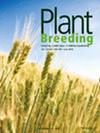Flavour improvement in early generations of fresh market tomatoes (Solanum lycopersicum): I. Identification of QTL for sensory attributes, physicochemical measurements and volatile compounds
IF 1.5
4区 农林科学
Q2 AGRONOMY
引用次数: 0
Abstract
Human sensory analysis is the most appropriate method for assessing the flavour of fresh market tomatoes, but it is very labour and time consuming. Therefore, sensory attributes are often neglected in early generations of breeding programmes and genetic studies, although there is a demand for tomatoes with improved flavour. In this study, the recently developed Breeders' Sensory Test was applied to an F新鲜上市番茄(Solanum lycopersicum)早期世代的风味改良:I. 感官属性、理化测量和挥发性化合物 QTL 的鉴定
人体感官分析是评估新鲜上市番茄风味的最合适方法,但非常耗费人力和时间。因此,在早期的育种计划和遗传研究中,感官属性往往被忽视,尽管人们对风味更好的番茄有需求。本研究将最近开发的 "育种者感官测试 "应用于由两个具有优良风味的亲本产生的 F2 映射群体。在有机低投入栽培和水培条件下,对感官属性、理化指标、挥发性物质和果实重量进行了评估。绘制了一幅跨度为 1070 cM 的连接图。在两种栽培系统的手段中,共检测到 71 个数量性状位点(QTL),其中 61 个为有机栽培,46 个为水培栽培。27%的基因座在两种栽培系统之间共定位。在与风味相关的性状中发现了 9 个不同的 QTL 群,其中包括 6 号染色体上的一个大群,由 5 个感官 QTL 和 9 个挥发性 QTL 组成。建议对染色体 2、5、6、10 和 11 上的感官 QTL(部分在群内)进行标记辅助选择。
本文章由计算机程序翻译,如有差异,请以英文原文为准。
求助全文
约1分钟内获得全文
求助全文
来源期刊

Plant Breeding
农林科学-农艺学
CiteScore
4.40
自引率
5.00%
发文量
74
审稿时长
3.0 months
期刊介绍:
PLANT BREEDING publishes full-length original manuscripts and review articles on all aspects of plant improvement, breeding methodologies, and genetics to include qualitative and quantitative inheritance and genomics of major crop species. PLANT BREEDING provides readers with cutting-edge information on use of molecular techniques and genomics as they relate to improving gain from selection. Since its subject matter embraces all aspects of crop improvement, its content is sought after by both industry and academia. Fields of interest: Genetics of cultivated plants as well as research in practical plant breeding.
 求助内容:
求助内容: 应助结果提醒方式:
应助结果提醒方式:


